|
Introduction
The value and importance of the army were realized very early in the
history of India, and this led in course of time to the maintenance
of a permanent militia to put down dissensions. War or no war, the
army was to be maintained, to meet any unexpected contingency. This
gave rise to the Ksatriya or warrior caste, and the ksatram dharman
came to mean the primary duty of war. To serve the country by
participating in war became the svadharma or this warrior community.
The necessary education, drill, and discipline to cultivate
militarism were confined to the members of one community, the
Ksatriyas. This prevented the militant attitude from spreading to
other communities and kept the whole social structure unaffected by
actual wars and war institutions.
Says the Arthva Veda:
"May we revel, living a hundred
winters, rich in heroes."
The whole country looked upon the
members of the ksatriya community as defenders of their country and
consequently did not grudge the high influence and
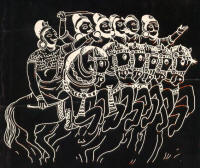 power wielded by
the Ksatriyas, who were assigned a social rank next in importance to
the intellectual and spiritual needs of the society. power wielded by
the Ksatriyas, who were assigned a social rank next in importance to
the intellectual and spiritual needs of the society.
The ancient
Hindus were a sensitive people, and their heroes were instructed
that they were defending the noble cause of God, Crown and
Country.
Viewed in this light, war departments were 'defense' departments and
military expenditure were included in the cost of defense. In this,
as in many cases, ancient India was ahead of modern ideas.
Chivalry, individual heroism, qualities of mercy and nobility of
outlook even in the grimmest of struggles were not unknown to the
soldiers of ancient India. Thus among the laws of war, we find that,
(1) a warrior (Khsatriya) in
armor must not fight with one not so clad
(2) one should fight only one
enemy and cease fighting if the opponent is disabled
(3) aged men, women and
children, the retreating, or one who held a straw in his
lips as a sign of unconditional surrender should not be
killed
It is of topical interest to note that
one of the laws enjoins the army to leave the fruit and flower
gardens, temples and other places of public worship unmolested.
Terence Duke, author of
The Boddhisattva
Warriors: The Origin, Inner Philosophy, History and Symbolism of the
Buddhist Martial Art Within India and China, martial arts went from India to China. Fighting
without weapons was a specialty of the ancient Ksatreya warriors of
India.
Back to Contents
Territorial
ideal of a one-State India
Imperial sway in ancient India meant the active rule of an
individual monarch who by his ability and prowess brought to
subjection the neighboring chieftains and other rulers, and
proclaimed himself the sole ruler of the earth. This goes by the
name of digvi-jaya. It is not necessary that he should conquer all
States by the sword. A small state might feel the weight of a
conquering king and render obeisance of its own accord.
According to the Sangam classics, each of the respective rulers of
the chief Tamil kingdoms, the Cera, Cola and Pandya, carried his
sword as far north as the Himalayas, and implanted on its lofty
heights his respective crest the bow, the tiger and the fish. In
these adventures which the Tamil Kings underwent for their
glorification, they did not lag behind their northern brethren. The
very epithet Imayavaramban shows that the limits of the empire under
that Emperor extended to the Himalayas in the north.
This title was
also earned by Ceran Senguttuvan by his meritorious exploits in the
north. Names like the Cola Pass in the Himalayan slopes, which in
very early times connected Nepal and Bhutan with ancient Tibet, give
a certain clue to the fact that once Tamil kings went so far north
as the Himalayas and left their indelible marks in those regions.

Kshatriya Warrior (Now in Indian Museum, Calcutta).
If in the epic age a Rama and an
Arjuna could come to the extremity
of our peninsula, and in the historical period of a Chandragupta or
a Samudragupta could undertake an expedition to this part of our
country, nothing could prevent a king of prowess and vast resources
like the Cera king Senguttuvan from carrying his
 armies to the
north. The route lay through the Dakhan plateau, the Kalinga, Malva,
and the Ganga. Perhaps it was the ancient Daksinapatha route known
to history from the epoch of the Rg Veda Samhita. armies to the
north. The route lay through the Dakhan plateau, the Kalinga, Malva,
and the Ganga. Perhaps it was the ancient Daksinapatha route known
to history from the epoch of the Rg Veda Samhita.
The king who became conqueror of all India was entitled to the
distinction of being called a Samrat. In the Puranic period the
great Kartavirya Arjuna of the Haihaya clan spread his arms
throughout the ancient Indian continent and earned the title of
Samrat.
The same principle of glory and distinction underlay the
performance of the sacrifice, Asvamedha and Rajasuya, which were
intended only for the members of the Ksatriya community.
This bears testimony to ' the existence of the territorial ideal of
a one-State India' (Cakravartiksetram of Kautalya). These kings were
called Sarvabhaumas and Ekarats.
Vedic kings aimed at it, and epic rulers realized it. The idea of
ekarat, continued down to Buddhist times and even later. The Jatakas
which are said to belong to the fifth and sixth century B.C., make
pointed reference to an all-Indian empire.
This concept of an
all-India empire stretching from Kanyakumari to the Himalayas,
according to Kautalya receives further support from another
important political term: ekacchatra, or one-umbrella sovereignty.
Hindus have given shelter to the persecuted people from many lands
and in all ages. But what is most important, they have always
regarded their own homeland as the only playfield for their
chakravartins, and never waged wars of conquest beyond the borders
of Bharata-varsha.
Back to Contents
The Laws of
War
When society became organized and a warrior caste (Kshatriya) came
into being, it was felt that the members of this caste should be
governed by certain humane laws, the observance of which, it was
believed, would take them to heaven, while their non-observance
would lead them into hell. In the post Vedic epoch, and especially
before the epics were reduced to writing, lawless war had been
supplanted, and a code had begun to govern the waging of wars. The
ancient law-givers, the reputed authors of the Dharmasutras and the
Dharmasastras, codified the then existing customs and usages for the
betterment of mankind. Thus the law books and the epics contain
special sections on royal duties and the duties of common warriors.
It is a general rule that kings were chosen from among the Kshatriya
caste. In other words, a non-Ksatriya was not qualified to be a
king. And this is probably due to the fact that the kshatriya caste
was considered superior to others in virtue of its material prowess.
Though the warrior's code enjoins that all the Ksatriyas should die
on the field of battle, still in practice many died a peaceful
death. There is a definite ordinance of the ancient law books
prohibiting the warrior caste from taking to asceticism.
Action and
renunciation is the watch-word of the Ksatriya. The warrior was not
generally allowed to don the robes of an ascetic. But Mahavira and
Gautama protested against these injunctions and inaugurated an order
of monks or sannyasins. When these dissenting sects gathered in
strength and numbers, the decline of Ksatriya valor set in. Once
they were initiated into a life of peace and prayer, they preferred
it to the horrors of war. this was a disservice that dissenting
sects did to the cause of ancient India.
When a conqueror felt that he was in a position to invade the
foreigner's country, he sent an ambassador with the message: 'Fight
or submit.'
More than 5000 years ago India recognized that the
person of the ambassador was inviolable. This was a great service
that ancient Hinduism rendered to the cause of international law. It
was the religious force that invested the person of the herald or
ambassador with an inviolable sanctity in the ancient world.
The
Mahabharata rules that the king who killed an envoy would sink into
hell with all his ministers.

The Mahabharata War
Dharmayuddha is war carried on the principles of Dharma, meaning
here the Ksatradharma or the law of Kings and Warriors.
The Hindu laws of war are very chivalrous and humane, and prohibit
the slaying of the unarmed, of women, of the old, and of the
conquered.
Megasthenes noticed a peculiar trait of Indian warfare they never
ravage an enemy's land with fire, nor cut down its trees.
The Bhagavad Gita has influenced great Americans from Thoreau to
Oppenheimer.
Its message of letting go of the fruits of one’s
actions is just as relevant today as it was when it was first
written more than two millennia ago.
As early as as the 4th century B.C. Megasthenes noticed a peculiar
trait of Indian warfare.
"Whereas among other nations it is usual, in the contests of war, to
ravage the soil and thus to reduce it to an uncultivated waste,
among the Indians, on the contrary, by whom husbandmen are regarded
as a class that is sacred and inviolable, the tillers of the soil,
even when battle is raging in their neighborhood, are undisturbed by
any sense of danger, for the combatants on either side in waging the
conflict make carnage of each other, but allow those engaged in
husbandry to remain quite unmolested. Besides, they never ravage an
enemy's land with fire, nor cut down its trees."
(source: A Brief History of India - By Alain Danielou p. 106).
The
modern "scorched earth" policy was then unknown. "
Professor H. H. Wilson says:
"The Hindu laws of war are very
chivalrous and humane, and prohibit the slaying of the unarmed, of
women, of the old, and of the conquered."
At the very time when a battle was going on, be says, the
neighboring cultivators might be seen quietly pursuing their work, -
" perhaps ploughing, gathering for crops, pruning the trees, or
reaping the harvest." Chinese pilgrim to Nalanda University, Hiuen
Tsiang affirms that although the there were enough of rivalries and
wars in the 7th century A.D. the country at large was little injured
by them.
Back to Contents
Weapons of War
as Gathered from Literature
Dhanur Veda classifies the weapons of offence and defense into four
- the mukta, the amukta, the mukta-mukta and the yantramukta. The
Nitiprakasika, on the other hand, divides them into three broad
classes, the mukta (thrown), the amukta (not thrown), and the
mantramukta (discharged by mantras).
The bows and arrows are the
chief weapons of the mukta group.
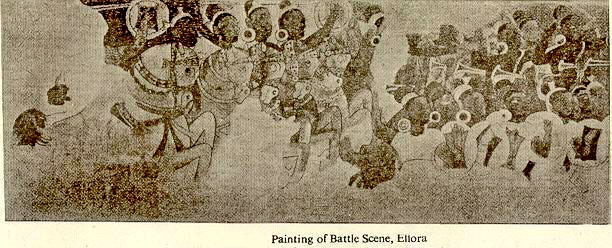
The very fact that our military
science named Dhanur Veda provides sufficiently clearly that the bow
and arrow were the principle weapons of war in those times. It was
known by different terms as sarnga, kodanda, and karmuka. Whether
these are synonyms of the same thing or were different is difficult
to say. The Rg vedaic smith was not only a steel worker but also an
arrow maker.
Fire-Arms:
It would be interesting to examine the true nature of the
agneya-astras. Kautalya describes agni-bana, and mentions three
recipes - agni-dharana, ksepyo-agni-yoga, and visvasaghati.
Visvasaghati was composed of 'the powder of all the metals as red as
fire or the mixture of the powder of kumbhi, lead, zinc, mixed with
the charcoal and with oil wax and turpentine.' From the nature of
the ingredients of the different compositions it would appear that
they were highly inflammable and could not be easily extinguished.
A recent writer remarks:
'The Visvasaghati-agni-yoga was virtually a
bomb which burst and the fragments of metals were scattered in all
directions. The agni-bana was the fore-runner of a gun-shot.....
Sir A. M. Eliot tells us that the Arabs learnt the manufacture of
gunpowder from India, and that before their Indian connection they
had used arrows of naptha. It is also argued that though Persia
possessed saltpetre in abundance, the original home of gunpowder was
India. It is said that the Turkish word top and the Persian tupang
or tufang are derived from the Sanskrit word dhupa. The dhupa of the
Agni Purana means a rocket, perhaps a corruption of the Kautaliyan
term natadipika.
(source: Fire-Arms in Ancient India - By Jogesh Chandra Ray I.H.Q.
viii. p. 586-88).
Heinrich Brunnhofer (1841-1917), German Indologist, also believed
that the ancient Aryans of India knew about gunpowder.
(source: German Indologists: Biographies of Scholars in Indian
Studies writing in German - By Valentine Stache-Rosen. p.92).
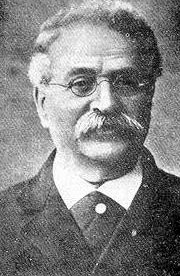 Gustav Oppert (1836-1908) born in Hamburg, Germany, he taught
Sanskrit and comparative linguistics at the Presidency College,
Madras for 21 years. He was the Telugu translator to the Government
and Curator, Government Oriental Manuscript Library. Translated
Sukraniti, statecraft by an unknown author. Gustav Oppert (1836-1908) born in Hamburg, Germany, he taught
Sanskrit and comparative linguistics at the Presidency College,
Madras for 21 years. He was the Telugu translator to the Government
and Curator, Government Oriental Manuscript Library. Translated
Sukraniti, statecraft by an unknown author.
He attempted to prove that ancient Indians knew firearms.
(source:
German Indologists: Biographies of Scholars in Indian
Studies writing in German - By Valentine Stache-Rosen. p.81. For more refer to article by G R Josyer -
India: The Home of
Gunpowder and Firearms).
In his work, Political Maxims of the Ancient Hindus, he says, that
ancient India was the original home of gunpowder and fire-arms. It
is probable that the word Sataghni referred to in the Sundara Kanda
of the Ramayana refers to cannon.
(source: Hindu Culture and The Modern Age - By Dewan Bahadur K.S.
Ramaswami Shastri - Annamalai University 1956 p. 127).
The word astra in the Sukraniti is interpreted by Dr. Gustav Oppert
as a bow. The term astra means a missile, anything which is
discharged. Agneya astra means a fiery arm as distinguished from a
firearm.
Dr. Oppert refers to half a dozen temples in South India to prove
the use of fire-arms in ancient India. The Palni temple in the
Madura District contains on the outer portion in an ancient stone
mantapa scenes of carved figures of soldiers carrying in their hands
small fire-arms, apparently the small-sized guns mentioned in the
Sukranitisara.
Again in the Sarnagapani temple at Kumbakonam in the
front gate of the fifth story from the top is the figure of a king
sitting in a chariot drawn by horses and surrounded by a number of
soldiers. Before this chariot march two sepoys with pistols in their
hands. In the Nurrukkal mantapam of the Conjeevaram temple is a
pillar on the north side of the mandapa. Here is a relief vividly
representing a flight between two bodies of soldiers. Mounted
horsemen are also seen.
The foot-soldier is shown aiming his
fire-arm against the enemy. Such things are also noted in the Tanjore temple and the temple at Perur, in the Coimbatore District.
In the latter there is an actual representation of a soldier loading
a musket.
The Borobudar in Java where Indian tradition is copied wholesale.
They are ascribed roughly to the period 750-850 A.D. There is a
striking relief series PL. I, fig. 5, (1605) representing a battle
in which two others are seen on each side, one wearing a curved
sword in the right hand and a long shield, and the other a mace and
a round shield resembling a wheel, all apparently made of iron. The
story of the Ramayana is also given as in the Tadpatri temple from
Rama's going to the forest down to the killing of Ravana. There is
also a wonderful sculpture of an ancient Hindu ship.
(source: Suvarnadvipa - By R.C. Majumdar. pp 194-5).
Medhatithi remarks thus "while fighting his enemies in battle, he
shall not strike with concealed weapons nor with arrows that are
poisoned or barbed on with flaming shafts."
Sukraniti while referring to fire-arms, (agneyastras) says that
before any war, the duty of the minister of war is to check up the
total stock of gunpowder in the arsenal. Small guns is referred as
tupak by Canda Baradayi. The installation of
yantras (engines of
war) inside the walls of the forts referred to by Manasollasa and
the reference of Sataghni (killer of hundreds of men) pressed into
service for the protection of the forts by Samaranganasutradhara
clearly reveals the frequent use of fire arms in the battle-field.
(source:
India Through The Ages: History, Art Culture and Religion -
By G. Kuppuram p. 512-513).

Lord Rama with his bow defeats Ravana in the gold city of Lanka.
In the light of the above remarks we can trace the evolution of
fire-arms in the ancient India. There is evidence to show that agni
(fire) was praised for vanquishing an enemy. The Arthava Veda shows
the employment of fire-arms with lead shots. The Aitareya Brahmana
describes an arrow with fire at its tip. In the Mahabharata and
Ramayana, the employment of agnyastras is frequently mentioned, and
this deserves careful examination in the light of other important
terms like ayah, kanapa and tula-guda.
The agnicurna or gunpowder was composed of 4 to 6 parts of saltpetre,
one part of sulphur, and one part of charcoal of arka, sruhi and
other trees burnt in a pit and reduced to powder. Here is certain
evidence of the ancient rockets giving place to actual guns in
warfare. From the description of the composition of gunpowder, the
composition of the Sukraniti can be dated at the pre-Gupta age.
(source:
War in Ancient India - By V. R. Ramachandra Dikshitar 1944.
p. 103 -105).
Bow and Arrow:
In the words of H. H. Wilson:
"the Hindus cultivated archery most
assiduously and were very Parthians in the use of the bow on
horse-back."
One feature of this weapon was that it could be handled
by all the four classes of warriors.

Frescos on the Angkor Wat depict scenes from the Hindu epics
Mahabharata and Ramayana, showing Kshatriyas engaged in war.
For more refer to chapter on
Greater India: Suvarnabhumi and
Sacred
Angkor
Other Weapons:
The Bindipala and the nine following are minor weapons of this
class. Probably this was a heavy club which had a broad and bent
tail end, measuring one cubit in length. It was to be used with the
left foot of the warrior placed in front. The various uses of this
weapon were cutting, hitting, striking and breaking. It was like a
kunta but with a big blade. It was used by the Asuras in their fight
with Kartavirya Arjuna.
The Nalika is a hand gun or musket rightly piercing the mark. It was
straight in form and hollow inside. It discharged darts if ignited.
As has been already said, Sukracarya speaks of two kinds of nalika,
one big and the other small. The small one, with a little hole at
the end, measured sixty angulas (ie. distance between the thumb and
the little finger) dotted with several spots at the muzzle end.
Through the touch hole or at its breach which contained wood, fire
was conveyed to the charge. It was generally used by foot-soldiers.
But the big gun had no wood at the breach and was so heavy that it
had to be conveyed in carts. The balls were made of iron, lead or
other material. Kamandaka uses the word nalika in the sense of
firing gun as a signal for the unwary king. Again in the Naisadha, a
work of the medieval period, Damayanti is compared to the two bows
of the god of love and goddess of love, and her two nostrils to the
two guns capable of throwing balls.
Thus there is clear evidence of the existence and use of firing guns
in India in very early times.
The Cakra, the next weapon in the category, is a circular disc with
a small opening in the middle. It was of three kinds of eight, six
and four spokes. It was used in five or six ways. It resembled the
quoid of the Sikhs today. Lord Vishnu is popularly addressed as
Sankha-cakra-gada-pani, that is having Sankha or conch, Cakra or
disc, and Gada or mace in three of his four hands.The various uses
of a disc were felling, whirling, rending, breaking, severing, and
cutting. It is one of the instruments peculiar to Lord Vishnu.
Kautalya speaks of it as a movable machine. The Cakra belongs to the
category of a missile. According to the Vamanapurana, the Cakra has
lustrous and sharp edges.
The Tomara is another weapon of war frequently mentioned in all
kinds of warfare. It was of two kinds, an iron club (sarvayasam) and
a javelin. . According to the Agni Purana it was to be with the help
of an arrow of straight feathers, and was powerful in dealing blows
to the eyes and hands of an enemy.

The Dantakanta, is another weapon of war, perhaps the shape of a
tooth, made of metal, of strong handle and a straight blade. It had
two movements.
The Pasa, which is a noose killing the enemy at one stroke, of two
or tree ropes used as a weapon attributed to the god Varuna. It was
triangular in shape and embellished with balls of lead. It was
associated with three kinds of movements. In the Agni Purana are
described eleven ways of turning it to one's own advantage by
dexterity of hand.
The Masundi, was probably an eight sided cudgel. It was furnished
with a broad and strong handle. It apparently comes from the
root-meaning to cleave or break into pieces, and perhaps akin to the
Musala.
All these and more found used in one battle or another both in the
Mahabharata and the Ramayana.
Amukta Weapons
The first of the Amukta weapons was the Vajra or the thunderbolt.
The origin of this weapon is given in the Rirthayatra portion of the
Mahabharata. It was made out of the backbone of the Rishi Dadhici
which was freely given by him to Indra. Originally perhaps it had
six sides and made a terrible noise when hurled.

-
The Parasu is the battle-axe attributed to Parasu-rama, of great
fame. Its blade was made of steel and it had a wooden handle. There
were six ways of manipulating it to one's own advantage.
-
The Gada is a heavy rod of iron with one hundred spikes on the top.
One of the four cubits was able to destroy elephants and rocks. It
could be handled in twenty different ways. By means of gun powder it
could be used as a projectile weapon of war. Its principal use was
to strike the enemy either from a raised place or from both sides
and strike terror into the enemy especially of the Gomutra array.
-
The Mudgara was a staff in the shape of a hammer. It was used to
break heavy stones and rocks. This is again a movable machine
according to Kautalya.
-
The Sira was a bucket-like instrument curved on both sides and with
a wide opening made of iron. It was as long as a man's height. The
Pattisa is a razor like weapon.
-
The Sataghni, literally means that which had the power of killing a
hundred at a time. It looked like a Gada and is said to be four
cubits in length. It is generally identified with modern cannon and
hence was a projectile weapon of war.
It was generally placed on the walls of a fort and is included among
the movable machines by Kautalya.
-
Asi or the Swords - The best sword measured fifty inches. They were
usually made of Pindara iron found in the Jangala country, black
iron in the Anupa, white iron in the Sataharana, gold colored in the
Kalinga, oily iron in the Kambhoja, blue-colored in Gujarat,
grey-colored in the Maharashtra and reddish white in Karnataka. The
aSi si also known as Nistrimsa, Visamana, Khadga, Tiksnadhara,
Durasada, Srigarbha, Vijaya and Dharmamula, meaning respectively
cruel, fearful, powerful, fiery, unassailable, affording wealth,
giving victory, and the source of maintaining dharma. And these are
generally the characteristics of a sword.
It was commonly worn on the left side and was associated with
thirty-two different movements. It measured 50 thumbs in length and
four inches in width. In the Santi-parva (166,3 ff; 82 ff). Bhisma
being asked as to which weapon in his opinion was the best for all
kinds of fighting, replies that the sword is the foremost among arms
(agryah praharananam), but the bow is first (adyam).
B.K. Sarkar says that the secret of manufacturing the so-called
Damascus blade was learnt by the Saracens from the Persians, who, in
their turn, had learnt it from the Hindus. Early Arabic literature
provides us with a curious illustration of the esteem with which
Indian swords were looked upon in Western Asia.
An early Arabic
poet, Hellal, describing the flight of the Hemyarites, says:
"But
they fled under its (ie. the clouds) small hail of arrows quickly,
whilst hard Indian swords were penetrating them." and again: "He
died and we inherited him; one old wide (cuirass) and a bright
Indian (sword) with a long shoulder-belt."
(Hindu Achievements in
Exact Science - By B. K. Sarkar p. 45).
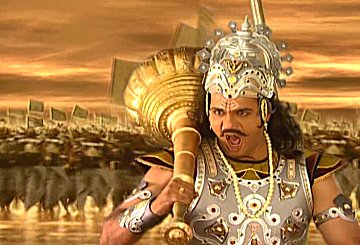
Note: Hindus made the best swords in the ancient world, they
discovered the process of making Ukku steel, called Damascus steel
by the rest of the world (Damas meaning water to the Arabs, because
of the watery designs on the blade). These were the best swords in
the ancient world, the strongest and the sharpest, sharper even than
Japanese katanas. Romans, Greeks, Arabs, Persians, Turks, and
Chinese imported it.
The original Damascus steel - the world's first
high-carbon steel - was a product of India known as wootz. Wootz is
the English for ukku in Kannada and Telugu, meaning steel. Indian
steel was used for making swords and armor in Persia and Arabia in
ancient times. Ktesias at the court of Persia (5th c BC) mentions
two swords made of Indian steel which the Persian king presented
him. The pre-Islamic Arab word for sword is 'muhannad' meaning from
Hind. So famous were they that the Arabic word for sword was Hindvi
- from Hind.
Wootz was produced by carburizing chips of wrought iron in a closed
crucible process.
"Wrought iron, wood and carbonaceous matter was
placed in a crucible and heated in a current of hot air till the
iron became red hot and plastic. It was then allowed to cool very
slowly (about 24 hours) until it absorbed a fixed amount of carbon,
generally 1.2 to 1.8 per cent," said eminent metallurgist Prof.
T.R.
Anantharaman, who taught at Banares Hindu University, Varanasi.
"When forged into a blade, the carbides in the steel formed a
visible pattern on the surface."
To the sixth century Arab poet Aus
b. Hajr the pattern appeared described 'as if it were the trail of
small black ants that had trekked over the steel while it was still
soft'. In the early 1800s, Europeans tried their hand at reproducing
wootz on an industrial scale. Michael Faraday, the great
experimenter and son of a blacksmith, tried to duplicate the steel
by alloying iron with a variety of metals but failed.
Some
scientists were successful in forging wootz but they still were not
able to reproduce its characteristics, like the watery mark.
"Scientists believe that some other micro-addition went into it,"
said Anantharaman.
"That is why the separation of carbide takes
place so beautifully and geometrically."
The crucible process could have originated in south India and the
finest steel was from the land of Cheras, said K. Rajan, associate
professor of archaeology at Tamil University, Thanjavur, who
explored a 1st century AD trade centre at Kodumanal near Coimbatore.
Rajan's excavations revealed an industrial economy at Kodumanal.
Pillar of strength The rustless wonder called the Iron Pillar near
the Qutb Minar at Mehrauli in Delhi did not attract the attention of
scientists till the second quarter of the 19th century.
The
inscription refers to a ruler named Chandra, who had conquered the Vangas and Vahlikas, and the breeze of whose valour still perfumed
the southern ocean. "The king who answers the description is none
but Samudragupta, the real founder of the Gupta empire," said Prof.
T.R. Anantharaman, who has authored The Rustless Wonder. Zinc
metallurgy travelled from India to China and from there to Europe.
As late as 1735, professional chemists in Europe believed that zinc
could not be reduced to metal except in the presence of copper.
The
alchemical texts of the mediaeval period show that the tradition was
live in India. In 1738, William Champion established the Bristol
process to produce metallic zinc in commercial quantities and got a
patent for it. Interestingly, the mediaeval alchemical text Rasaratnasamucchaya describes the same process, down to adding 1.5
per cent common salt to the ore.
(source:
Saladin's sword - By The Week - June 24, 2001 -
http://netinfo.hypermart.net/telingsteel.htm).
Artillery - India Taught Europe
Artillery was introduced into Europe by the Roma (Gypsies), who
were none else than the Jats and Rajputs of India.
This has been revealed in a study by a reputed linguist, Weer
Rajendra Rishi, after an extensive tour of Roma camps in Europe.
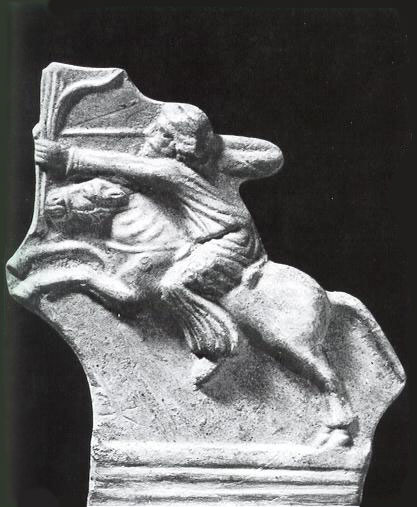
He explains that the Romas, who are the Gypsies of Europe, also
taught the use of artillery to Europeans. These Roma belonged to the
Jat and Rajput clans who left India during the invasions by Mohamud
Ghaznavi and Mohammad Ghori between the 10th and 12th centuries of
the Christian era.
He says the use of artillery was known in Asia, notably in India,
from time immemorial, while it was introduced to the Europeans much
later.
Mr. Rishi reveals that the Roma had helped different countries of
Europe in making artillery.
“Evidence of this is given as early as
1496 by a mandate of that date granted by Wadislas, King of Hungary,
wherein it is said that Thomas Polgar, chief of 25 tents of
wandering Gypsies had, with his people, made at Funfkirchen
musket-balls and other ammunition for Bishop Sigismond.
“In 1546
when the English were holding Boulogne against the French the latter
took the help of two experienced Romas of Hungary to make great
number of cannons of greater caliber than earlier guns. The
Hungarian Roma of the 16th century possessed fuller knowledge of
fabricating artillery than the races of Western Europe.
There were also records that the Roma were employed as soldiers by
some countries of Europe. Dr. W. R. Rishi, is the author of the
book, Roma - The Panjabi Emigrants in Europe, Central and Middle
Asia, the USSR, and the Americas - published 1976. Mr. Rishi is a
well-known linguist of India and was awarded the honour of 'Padmashri'
by the President of India in 1970 for his contributions in the field
of linguistics. He is also the Founder Director of the Indian
Institute of Romani Studies.
(source: Diamonds, Mechanism, Weapons of War, Yoga Sutras - By G. R. Josyer. p. 179-182).
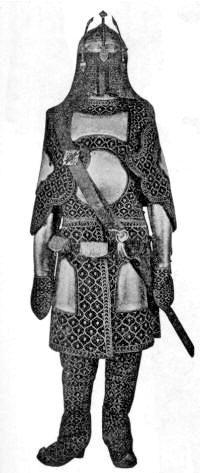
Indian Armour
To conclude with the words of Sir George Birdwood:
" For a variety, extent, and gorgeousness, and ethnological and
artistic value, no such collection of Indian arms exists in this
country (England) as that belonging to the Prince of Wales. It
represents the armorer's art in every province of India, from the
rude spear of the savage Nicobar islanders to the costly damascened,
sculptured, and jewelled swords, and shields, spears, daggers, and
match-locks of Kashmir, Kutch and Vizianagaram. The most striking
object in the collection is a suit of armor made entirely of the
horny scales of the Indian armadillo, or pangolin, encrusted with
gold, and turquoise, and garnets."
(source: The Industrial Arts of India pp. 171-2).
Back to Contents
Martial Arts -
Fighting without weapons
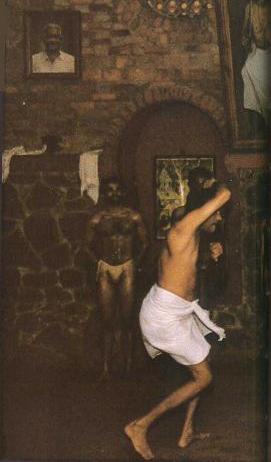 
Fighting without weapons was a specialty of the Ksatreya (caste of
Ancient India) and foot soldier alike.
Danger and Divinity: Originating at least 1,300 years ago, India's
Kalaripayit is the oldest martial art taught today.
It is also one
of the most potentially violent.
Weaponless but nimble, a karaipayit
master displays for his students how to meet the attack of an armed
opponent.
Watch
Kalari Martial Arts and
Silambam Martial Arts videos
"Fighting without weapons was a specialty of the Ksatreya (caste of
Ancient India) and foot soldier alike. For the Ksatreya it was simply
part and parcel of their all around training, but for the lowly
peasant it was essential. We read in the Vedas of men unable to
afford armor who bound their heads with turbans called Usnisa to
protect themselves from sword and axe blows.
"Fighting on foot for a Ksatreya was necessary in case he was
unseated from his chariot or horse and found himself without
weapons. Although the high ethical code of the Ksatreya forbid
anyone but another Ksatreya from attacking him, doubtless such
morals were not always observed, and when faced with an unscrupulous
opponent, the Ksatreya needed to be able to defend himself, and
developed, therefore, a very effective form of hand-to-hand combat
that combined techniques of wrestling, throws, and hand strikes.
Tactics and evasion were formulated that were later passed on to
successive generations. This skill was called Vajramukhti, a name
meaning "thunderbolt closed - or clasped - hands." The tile
Vajramukti referred to the usage of the hands in a manner as
powerful as the vajra maces of traditional warfare. Vajramukti was
practiced in peacetime by means of regular physical training
sessions and these utilized sequences of attack and defense
technically termed in Sanskrit nata."

Kalaripayattu, literally “the way of the battlefield,” still
survives in Kerala, where it is often dedicated to Mahakali. The
Kalari grounds are usually situated near a temple, and the pupils,
after having touched the feet of the master, salute the ancestors
and bow down to the Goddess, begin the lesson. Kalari trainings have
been codified for over 3000 years and nothing much has changed.
The warming up is essential and demands great suppleness. Each
movement is repeated several times, facing north, east, south and
west, till perfect loosening is achieved. The young pupils pass on
to the handling of weapons, starting with the “Silambam”, a short
stick made of extremely hard wood, which in the olden times could
effectively deal with swords. The blows are hard and the parade must
be fast and precise, to avoid being hit on the fingers!
They
continue with the swords, heavy, and dangerous, even though they are
not sharpened any more, as they are used. Without guard or any kind
of body protection; they whirl, jump and parry, in an impressive
ballet. Young, fearless girls fight with enormous knives, bigger
than their arms and the clash of irons is echoed in the ground. The
session ends with the big canes, favorite weapons of the Buddhist
traveler monks, which they used during their long journey towards
China to scare away attackers.
The “Urimi” is the most extraordinary weapon of Kalari, unique in
the world. This double-edged flexible sword which the old-time
masters used to wrap around the waist to keep coiled in one hand, to
suddenly whip at the opponent and inflict mortal blows, is hardly
used today in trainings, for it is much too dangerous.
This indigenous martial arts, under the name of Kalari or
Kalaripayit exists only in South India today. Kalarippayat is said
to be the world's original martial art. Originating at least 1,300
years ago, India's Kalaripayit is the oldest martial art taught
today. It is also the most potentially violent, because students
advance from unarmed combat to the use of swords, sharpened flexible
metal lashes, and peculiar three-bladed daggers.
More than 2,000
years old, it was developed by warriors of the Cheras kingdom in
Kerala. Training followed strict rituals and guidelines. The
entrance to the 14 m-by-7 m arena, or kalari, faced east and had a
bare earth floor. Fighters took Shiva and Shakti, the god and
goddess of power, as their deities. From unarmed kicks and punches,
kalarippayat warriors would graduate to sticks, swords, spears and
daggers and study the marmas—the 107 vital spots on the human body
where a blow can kill. Training was conducted in secret, the lethal
warriors unleashed as a surprise weapon against the enemies of
Cheras.
Father and founder of Zen Buddhism (called C’han in China),
Boddidharma, a Brahmin born in Kacheepuram in Tamil Nadu, in 522
A.D. arrived at the courts of the Chinese Emperor Liang Nuti, of the
6th dynasty. He taught the Chinese monks Kalaripayattu, a very
ancient Indian martial art, so that they could defend
 themselves
against the frequent attacks of bandits. In time, the monks became
famous all over China as experts in bare-handed fighting, later
known as the Shaolin boxing art. themselves
against the frequent attacks of bandits. In time, the monks became
famous all over China as experts in bare-handed fighting, later
known as the Shaolin boxing art.
The
Shaolin temple which has been
handed back a few years ago by the communist Government to the C’han
Buddhist monks, inheritors of Boddhidharma’s spiritual and martial
teachings, by the present Chinese Government, is now open to
visitors. On one of the walls, a fresco can be seen, showing Indian
dark-skinned monks, teaching their lighter-skinned Chinese brothers
the art of bare-handed fighting.
On this painting are inscribed:
“Tenjiku Naranokaku” which means: “the fighting techniques to train
the body (which come) from India…”
Kalari payatt was banned by the British in 1793.
(source:
The Boddhisattva Warriors: The Origin, Inner Philosophy,
History and Symbolism of the Buddhist Martial Art Within India and
China - By Terence Dukes/ Shifu Nagaboshi Tomio p. 3 - 158-174 and
242.
A Western Journalist on India: a ferengi's columns - By
Francois Gautier Har-Anand Publications January 2001 ISBN 8124107955
p. 155-158).
Silambam – Indian Stick Fighting
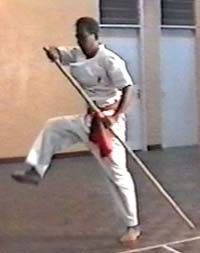 
The art Nillaikalakki Silambam was brought to the royal court
during
the reign of the Cheran, Cholan and Pandian emperors, once powerful
rulers of India.
Watch
Kalari Martial Arts and
Silambam Martial Arts videos
The art Nillaikalakki Silambam, which exists for more than five
thousand years, is an authentic art which starts with the stick
called Silambamboo (1.68 meters long). It originates from the Krunji
mountains of south India, and is as old as the Indian sub-continent
itself.
The natives called Narikuravar were using a staff called Silambamboo
as a weapon to defend themselves against wild animals, and also to
display their skill during their religious festivals. The Hindu
scholars and yogis who went to the Krunji mountains to meditate got
attracted by the display of this highly skilled spinning Silambamboo.
The art Nillaikalakki Silambam therefore became a part of the Hindu
scholars and yogis training, as they were taught by the Narikuravar.
They brought the art to the royal court during the reign of the
Cheran, Cholan and Pandian emperors, once powerful rulers of India.
(source:
Silamban – Indian Stick Fighting).
Back to Contents
Army and Army
Divisions
The Game of Chess and the Four-Fold Force
Owing to peculiar geographical features, with her vast plains
interspersed with forests, the ancient Indian States had to make
extensive use of mounted forces which comprised cavalry, chariots,
and elephants. This does not mean that infantry was neglected. Hindu
India possessed the classical fourfold force of chariots, elephants,
horsemen, and infantry, collectively known as the Caturangabala.
Students also know that the old game of chess also goes by the name
of Caturanga. Chess is a game of war, and in each game there are a
king, a councilor,
 two elephants, two horses, two chariots, and
eight foot-soldiers. From the references to this game in the Rg Veda
and the Atharva Veda and in the Buddhists and Jaina books, it must
have been very popular in ancient India. The Persian term Chatrang
and the Arabic Shatrang are forms of the Sanskrit Chaturanga. two elephants, two horses, two chariots, and
eight foot-soldiers. From the references to this game in the Rg Veda
and the Atharva Veda and in the Buddhists and Jaina books, it must
have been very popular in ancient India. The Persian term Chatrang
and the Arabic Shatrang are forms of the Sanskrit Chaturanga.
The famous epic Mahabharata narrates an incidence where a game
called Chaturang was played between two groups of warring cousins.
In some form or the other, the game continued till it evolved into
chess.
H.J.R. Murray, in his work titled “A History of Chess”, has
concluded that,
“chess is a descendant of an Indian game played in
the 7th century AD”. The Encyclopedia Britannica states that “we
find the best authorities agreeing that chess existed in India
before it is known to have been played anywhere else.”
On the whole the board is 8 X 8 squares. According to Taylor, the
game of chess was the invention of some Hindu who devised a game of
war with the astapada board as his field of battle. From the
reference to the game in the Rig Veda and the Arthava Veda and in
the Buddhist and Jaina books, it must have been very popular in
ancient India. It is to be noted that the relative values of the
chess pieces were analogous to or identical with the relative values
of different arms as laid down by Kautalya, Sukra, and Vaisampayana.
The organization of the Indian army which came to be known as
Caturanga, both in epic Sanskrit and Pali literature, was based on
the ancient game.
The Chariots
Chariots were used in warfare from very remote times.
There are many references to chariots in the Samhitas and in the
Brahmanas. The chariot was an indispensable instrument of war in the
days of the Vedas, and on its possession depended victory. In the Rg
Veda there is a hymn addressed to the war chariot: ' Lord of the
wood, be firm and strong in body: be bearing as a brave victorious
hero.
Show forth thy strength, compact with straps of leather and
let thy rider win all spoils of battle.' Chariots were of different
types and materials. In the Ramayana and the Mahabharata their use
is largely in evidence. Each chariot was marked off by its ensign
and banner. Besides flags, umbrellas (chattra, atapatra), and fans
were a part of the paraphernalia of the war chariot.
Sukra mentions
an awe-inspiring chariot of iron with swift-moving wheels, provided
with good seats for the warriors and a seat in the middle for the
charioteer; the chariot was also equipped with all kinds of
offensive and defensive weapons.

Warrior Arjuna with Krishna - driving the chariot in the epic The
Mahabharata.
The Bhagavad Gita has influenced great Americans from Thoreau to
Oppenheimer.
Its message of letting go of the fruits of one’s
actions is just as relevant today as it was when it was first
written more than two millennia ago.
The conception of the sun-god in Indian tales is of value to the
student of ancient Indian military history. The idea is that the
sun-god wants to destroy darkness. Therefore he dons a lustrous
armor and marching in his swift flying chariot drawn by seven
powerful steads, Aruna (dawn) being his charioteer. The whole image
presents a life-like portrait of the military dress as well as the
march against an enemy.
Elephants
The next important force of war consisted of elephants.
The numerous representations of the animal on coins and in
architectural sculptural works from Gandhara to Ramesvaram as well
as bronze figures in Indonesia are an indication of the esteem in
which it was held by the ancient Indians, clearly on account of its
usefulness.
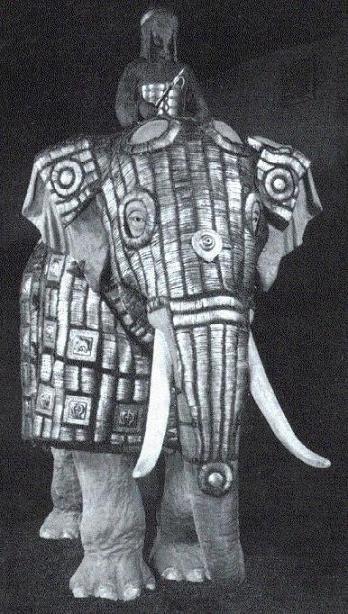
An Elephant Armour: An important force of war consisted of
elephants.
There is a reference in the Rg Veda to two elephants bending their
heads and rushing together against the enemy, which is a fairly
early reference to the animal being used in war. By the time of the
Yajur Veda Samhita the art of training elephants had become common.
The Arthasastra mentions a special officer of the State for the care
of elephants and lays down his duties.
Megasthenes explains how the
elephants were hunted, and how their distempers were cured by simple
remedies such as cow's milk for eye-disease and pig's fat for sores.
A Jataka story throws some light on how fire-weapons were used in
ancient India.
"Once a king mounted on an elephant and led an attack
on the city of Benares. The soldiers who offered defenses from
within the city gates discharged a shower of missiles against the
enemy at which the elephant was frightened a little."
The use of
burning naphtha balls thrown against on rushing elephants to
frighten them and make them turn back on their own side, is
mentioned by early Mohammadan historians as a feature of the warfare
between the Rajputs and the Turkish invaders from the North-West.
(Elliot and Dowson, vol. I).
Cavalry
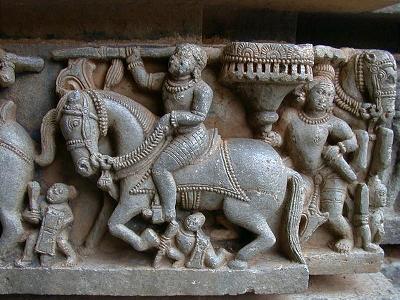
We hear from the Kautaliya and Megasthenes that
there was a
well-organized and efficient cavalry force in the army of Chandragupta.
In the ArthaVeda we hear of dust-raising horsemen.
We hear from the Kautaliya and Megasthenes that there was a
well-organized and efficient cavalry force in the army of
Chandragupta. In the ArthaVeda we hear of dust-raising horsemen. In
this connection it is interesting to consider the oft-repeated
statement that horses are non-Indian. It is not the whole truth.
They were known to the Asuras of Vedic literature. There is a legend
narrated in the third book of the Hariharacaturanga (though this is
work of the late 12th century A.D., the tradition recorded is very
ancient). In the epoch of the epics and the Arthasastra, we find
that the cavalry occupied as important a place in the army as any
other division.
Megasthenes corroborates the evidence of the Arthasastra. There was
a special department in the State for the cavalry. The horses of the
State were provided with stables and placed under the care of good
grooms and syces. There were several trained horsemen who could jump
forward and arrest the speed of galloping horses. But the majority
of them rode their horses with bit and bridle. When horses became
ungovernable they were placed in the hands of professional trainers
who made the animals gallop round in small circles. In selecting
horses of war, their age, strength, and size were taken into
account.
We may remark in passing that Abhimanyu's horses were only
three years old.

How important the science of horses was to the ancient Indians is
best seen from the Laksanaprakasa which quotes from several
important old authorities some of which are probably lost to us.
Among them are the Asvayurveda and Asvasastra, the former attributed
to Jayadeva and the latter to Nakula. Both the Puranas and the epics
agree that the horses of the Sindhu and Kamboja regions were the
finest breed and that the services of the Kambojas as cavalry
troopers were requisitioned in ancient wars.
In the Mahabharata war
the Kambojans (Cambodians) were enlisted. The steeds of Bahalika
were also highly esteemed. Horses had names and so did elephants.
Unlike the chariot horse, the cavalryman drove his animal with a
whip which was generally fixed to the wrist. This allowed his hand
free play. The cavalryman was armed with arrow or spear or sword. He
wore breastplate and turban (unsnisa). Worth noting is the fact that
horses were made to drink wine before actually marching to battle.
The tactical use of the cavalry was to break through the obstacles
on the way, to pursue the retreating enemy, to cover the flanks of
the army, to effect speedy communication with the various parts of
the army unobserved (bahutsara) and to pierce the enemy ranks from
the front to the rear. The cavalry was responsible, in a large
measure, for the safety and security of the army in entrenched
positions, forests or camps. It obstructed movements of supplies and
reinforcements to the enemy. In short, the cavalry was indispensable
in situations requiring quickness of movement.
Infantry
The next important division of the army was the infantry, or
foot-soldier. The Arthasastra speaks of the infantry as a separate
army department under the charge of a special officer of the State.
This receives confirmation from Megasthenes statement. Besides the
maula or hereditary troops which formed a considerable portion of
the army, there were,
-
the bhrta or mercenaries
-
the sreni or soldiers
supplied by the different group and guild organizations
-
the mitra
or soldiers supplied by allies
-
the amitra or deserters from the
enemy ranks
-
the atavi recruited from forest tribes
According
to the Sukraniti and the Kamandakanitsara, the army was to be made
as imposing as possible to frighten the enemy by its size. The
Agni-purana says that victory ever attends the army where
foot-soldiers are numerically strong.
The Sukraniti also mentions that foot-soldiers possessed fire-arms
when they fought.
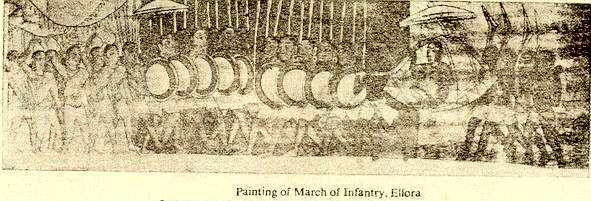
When these foot-soldiers equipped themselves for war
Arrian says
that,
'they carry a bow made of equal length with the man who bears
it. This they rest upon the ground and pressing against it and their
left foot, thus discharge the arrow having drawn the string
backwards: the shaft they use is little short of being three yards
long, and there is nothing which can resist an Indian Archer's shot
- neither shield nor breast-plate, nor any stronger defense if such
there be.'
In their left hand they carry bucklers made of undressed
ox-hide which are not so broad as those who carry them but are about
as long. If we turn to the ancient nations and especially the
ancient Egyptians we meet with almost a similar description.
The Commissariat
The Caturanaga was a classical division of the army accepted by
tradition. But in the epoch of the epic we hear of a Sadanga or the
six-fold army, including commissariat and admiralty. The use of
commissariat can be traced to the epic age. This belonged to the
category of administrative division of troops as against
 the
combatant. We are told that this division of the army into two
categories was first seen in the battle of Mansikert (1071 A.D.) the
combatant. We are told that this division of the army into two
categories was first seen in the battle of Mansikert (1071 A.D.)
But, centuries before, the Indian army leaders had realized the
value of such a division. It is said that when the Pandava army
marched to Kurukshetra it was followed by 'carts and transport cars,
and all descriptions of vehicles, the treasury, weapons and machines
and physicians and surgeons, along with the few invalids that were
in the army and all those that were weak and powerless. This was
purely a civil department attached to the army. Care was also given
to wounded animals.
The numerous references in our authorities to the Commissariat
demonstrate beyond doubt that wars were planned methodically and
conducted systematically.
The Admiralty
The Admiralty as a department of the State may have been a creation
of Chandragupta but there is evidence to show that the use of ships
and boats was known to the people of the Rig Veda. In the following
passage we have reference to a vessel with a hundred oars.
"This
exploit you achieved, Asvins in the ocean, where there is nothing to
give support, nothing to rest upon, nothing to cling to, that you
brought Bhujya, sailing in a hundred-cared ship, to his father's
house." (refer to Naval warfare section).
Cartography
There is no special word in Sanskrit for a 'a map.' There is,
however, reason to believe that in ancient India a map or chart was
regarded as a citra or alekhya, i.e., 'a painting, a picture, a
delineation'. That maps were made in ancient India seems to be quite
clear from the evidence of the New History of the T'ang Dynasty
which gives an account of the Chinese general Wang Hiuen-tse's
exploits in India in the year 648 A.D.
With reference to the knowledge of map-making among the people of
India, especially the Dravidians of the South:
"The charts in use by the medieval navigators of the Indian Ocean -
Dravidas, Arabs, Persians, were equal in value, if not superior, to
the charts of the Mediterranean. Marco Polo (1498) found them in the
hands of his Indian pilot, and their nature is fully explained in
the Mohit or 'the Encyclopaedia of the Sea'"
Hindu Valor
The Hindus were declared the by the Greeks to be the bravest nation
they ever came in contact with. (source: History of India - by
Mountstuart Elphinstone p. 197).
It was the Hindu King of Magadha that struck terror in the
ever-victorious armies of Alexander.

Abul Fazal, the minister of Akbar, after admiring their noble
virtues, speaks of the valor of the Hindus in these terms:
“Their
character shines brightest in adversity. Their soldiers (Rajputs)
know to what it is to flee from the fields of battle, but when the
success of the combat becomes doubtful, they dismount from their
horses and throw away their lives in payment of the debt of valor.”
Francois Bernier, a 17th century traveler says that:
“The Rajputs
embrace each other when on the battlefields as if resolved to die.”
The Spartans, as is well known, dressed their hair on such
occasions. It is well known that when a Rajput becomes desperate, he
puts on garments of saffron color, which act, in technical language,
is called kesrian kasumal karna (donning saffron robes).
(source: Hindu Superiority - By Har Bilas Sarda p. 79 - 91).
Back to Contents
Aerial Warfare
“The ancient Hindus could navigate the air, and not only navigate
it, but fight battles in it like so many war-eagles combating for
the domination of the clouds. To be so perfect in aeronautics, they
must have known all the arts and sciences related to the science,
including the strata and
 currents of the atmosphere, the relative
temperature, humidity, density and specific gravity of the various
gases...” currents of the atmosphere, the relative
temperature, humidity, density and specific gravity of the various
gases...”
~ Col. Henry S Olcott (1832 – 1907)
American author, attorney,
philosopher, and cofounder of the
Theosophical Society in a lecture
in Allahabad, in 1881.
"No question can be more interesting in the present circumstances of
the world than India’s contribution to the science of aeronautics.
There are numerous illustration in our vast Puranic and epic
literature to show how well and wonderfully the ancient Indians
conquered the air.
To glibly characterize everything found in this
literature as imaginary and summarily dismiss it as unreal has been
the practice of both Western and Eastern scholars until very
recently. The very idea indeed was ridiculed and people went so far
to assert that it was physically impossible for man to use flying
machines. But today what with balloons, airplanes…..”
Turning to Vedic literature, in one of the Brahmanas occurs the
concept of a ship that sails heavenwards. The ship is the Agnihotra
of which the Ahavaniya and Garhapatya fires represent the two sides
bound heavenward, and the steersman is the Agnihotrin who offers
milk to the three Agnis. Again in the still earlier Rg Veda Samhita
we read that the Asvins conveyed the rescued Bhujya safely by means
of winged ships. The latter may refer to the aerial navigation in
the earliest times.
In the recently published Samarangana Sutradhara of Bhoja, a whole
chapter of about 230 stanzas is devoted to the principles of
construction underlying the various flying machines and other
engines used for military and other purposes.
 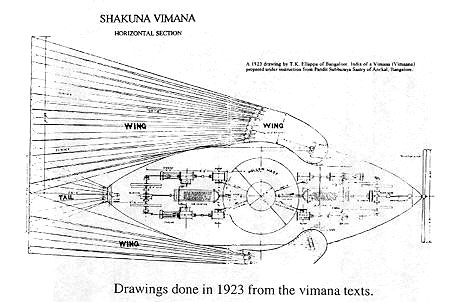
The ancient Hindus could navigate the air, and not only navigate it,
but fight battles in it like so many war-eagles combating for the
domination of the clouds
The various advantages of using machines, especially flying ones,
are given elaborately. Special mention is made of their use at one’s
will and pleasure, of their uninterrupted movements, of their
strength and durability, in short of their capability to do in the
air all that is done on earth. Three movements are usually ascribed
to these machines, - ascending, cruising thousands of miles in
different directions in the atmosphere and lastly descending.
It is
said that in an aerial car one can mount up to Suryamandala, ‘solar
region’ and the Naksatra mandala (stellar region) and also travel
throughout the regions of air above the sea and the earth. These
cars are said to move so fast as to make a noise that could be heard
faintly from the ground. The evidence in its favor is overwhelming.
An aerial car is made of light, wood looking like a great bird with
a durable and well-formed body having mercury inside and fire at the
bottom. It had two resplendent wings, and is propelled by air. It
flies in the atmospheric regions for a great distance and carries
several persons along with it. The inside construction resembles
heaven created by Brahma himself.
Iron, copper, lead and other
metals are also used for these machines. All these show how far art
and science was developed in ancient India in this direction. Such
elaborate description ought to meet the criticism that the vimanas
and similar aerial vehicles mentioned in ancient Indian literature
should be relegated to the region of myth.
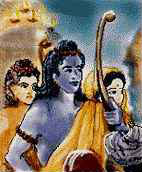 The ancient writers could certainly make a distinction between the
mythical which they designated as daiva and the actual aerial wars
designated as manusa. The ancient writers could certainly make a distinction between the
mythical which they designated as daiva and the actual aerial wars
designated as manusa.
After the great victory of Rama over Lanka, Vibhisana presented him
with the Puspaka vimana which was furnished with windows,
apartments, and excellent seats. It was capable of accommodating all
the vanaras besides Rama, Sita and Lakshman. Again in the
Vikramaurvaisya, we are told that king Puraravas rode in an aerial
car to rescue Urvasi in pursuit of the Danava who was carrying her
away.
Similarly in the Uttararamacarita in the flight between Lava
and Candraketu (Act VI) a number of aerial cars are mentioned as
bearing celestial spectators. There is a statement in the
Harsacarita of Yavanas being acquainted with aerial machines. The
Tamil work Jivakacintamani refers to Jivaka flying through the air.
Kathasaritsagara refers to highly talented woodworkers called
Rajyadhara and Pranadhara. The former was so skilled in mechanical
contrivances that he could make ocean crossing chariots. And the
latter manufactured a flying chariot to carry a thousand passengers
in the air. These chariots were stated to be as fast as thought
itself.
(source:
India Through The Ages: History, Art Culture and Religion -
By G. Kuppuram p. 532-533).
For more information refer to
Vymanika Shashtra.
Back to Contents
|


 armies to the
north. The route lay through the Dakhan plateau, the Kalinga, Malva,
and the Ganga. Perhaps it was the ancient Daksinapatha route known
to history from the epoch of the Rg Veda Samhita.
armies to the
north. The route lay through the Dakhan plateau, the Kalinga, Malva,
and the Ganga. Perhaps it was the ancient Daksinapatha route known
to history from the epoch of the Rg Veda Samhita. 

 Gustav Oppert (1836-1908) born in Hamburg, Germany, he taught
Sanskrit and comparative linguistics at the Presidency College,
Madras for 21 years. He was the Telugu translator to the Government
and Curator, Government Oriental Manuscript Library. Translated
Sukraniti, statecraft by an unknown author.
Gustav Oppert (1836-1908) born in Hamburg, Germany, he taught
Sanskrit and comparative linguistics at the Presidency College,
Madras for 21 years. He was the Telugu translator to the Government
and Curator, Government Oriental Manuscript Library. Translated
Sukraniti, statecraft by an unknown author.









 themselves
against the frequent attacks of bandits. In time, the monks became
famous all over China as experts in bare-handed fighting, later
known as the Shaolin boxing art.
themselves
against the frequent attacks of bandits. In time, the monks became
famous all over China as experts in bare-handed fighting, later
known as the Shaolin boxing art. 


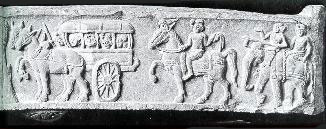
 two elephants, two horses, two chariots, and
eight foot-soldiers. From the references to this game in the Rg Veda
and the Atharva Veda and in the Buddhists and Jaina books, it must
have been very popular in ancient India. The Persian term Chatrang
and the Arabic Shatrang are forms of the Sanskrit Chaturanga.
two elephants, two horses, two chariots, and
eight foot-soldiers. From the references to this game in the Rg Veda
and the Atharva Veda and in the Buddhists and Jaina books, it must
have been very popular in ancient India. The Persian term Chatrang
and the Arabic Shatrang are forms of the Sanskrit Chaturanga. 




 the
combatant. We are told that this division of the army into two
categories was first seen in the battle of Mansikert (1071 A.D.)
the
combatant. We are told that this division of the army into two
categories was first seen in the battle of Mansikert (1071 A.D.)
 currents of the atmosphere, the relative
temperature, humidity, density and specific gravity of the various
gases...”
currents of the atmosphere, the relative
temperature, humidity, density and specific gravity of the various
gases...” 

 The ancient writers could certainly make a distinction between the
mythical which they designated as daiva and the actual aerial wars
designated as manusa.
The ancient writers could certainly make a distinction between the
mythical which they designated as daiva and the actual aerial wars
designated as manusa.